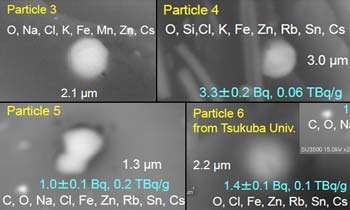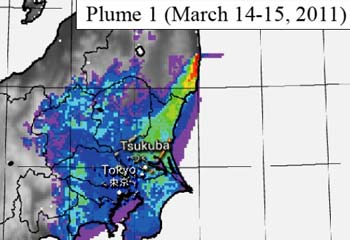http://www.asyura2.com/14/test30/msg/397.html
| Tweet |

200,000,000,000,000 becquerels/kg in fuel rod materials found near Tokyo… “the material spread globally” — Composed “major part” of worst Fukushima plume — Persists for long time in living organisms — Must reconsider disaster’s health effects (PHOTOS)
200兆ベクレル/ kgの燃料棒素材が東京の近くで発見... 「(燃料)素材は世界規模で拡散する」−最悪の福島プルームを構成する「大部分」−生命体に長期間存続する−災害の健康への影響を再考する必要あり(写真)
Published: August 11th, 2014 at 1:41 pm ET By ENENews
公開: 2014年8月11日、午後1:41 ET ENENewsによる
Presentation by Yasuhito Igarashi of Japan’s Meteorological Research Institute at IAEA’s expert meeting (pdf), Characteristics of Spherical Cs-Bearing Particles Collected during the Early Stage of FDNPP Accident, February 2014: […] We have found spherical Cs-bearing particles (Cs-ball) from HV filter samples collected during Mar. 14-15, 2011, when the first radioactive plume arrived from the FDNPP accident at the MRI [Meteorological Research Institute] as well as Univ. Tsukuba, Japan. […]
日本の気象研究所の五十嵐康人によるIAEA専門家会議でのプレゼンテーション(PDFファイル)、福島第一原子力発電所事故の早期に収集された球状セシウム含有粒子の特徴、2014年2月[...]我々は球状のセシウム含有粒子(セシウム・ボール)を、3月14〜15日に収集されたHVフィルター試料から発見した。その時に、最初の放射性プルームが、日本の筑波大学と同様に、MRI [気象研究所]に福島第一原発事故から到達した。 [...]
experiments showed that the Cs-ball occupied major part in the Mar. 14-15 Fukushima plume. They would persist for a long time in the environment as well as in living organisms. […] the investigation on radioactive aerosol during the second plume arrival gave no such Cs-ball. […] The finding should be a key to understand the processes of the FDNPP accident, to accurately evaluate the health and environmental impacts and to improve efficiency of the decontamination of the polluted area. […] Further studies are recommended for the present Cs-ball in more detail!
実験はセシウム・ボールが3月14−15日の福島プルームで大部分を占めていたことを示した。それらは環境内だけでなく、生体内で長期にわたって存続するだろう。 [...]第二プルーム到着時の放射性エアロゾルに関する調査は、そのようなセシウム・ボールを認めなかった。 [...]正確に健康や環境への影響を評価し、汚染地域の除染の効率を向上させるために、その所見は福島第一原発事故のプロセスを理解するための鍵であるはずです。 [...]現在のセシウム・ボールについてより詳細に、さらなる研究が推奨される!
Particle 5: 0.2 TBq/g (200 trillion Bq/kg)
Additional research on spherical particles: Nuclear fuel found 15 miles from Tokyo suburbs — Fukushima uranium in ‘glassy’ spheres transported over 170 km
粒子5:0.2 テラBq/ g(200兆ベクレル/ kg)
球状粒子に関する追加調査:核燃料は東京郊外15マイル(24キロメートル)から発見される−「ガラス状」球体の福島ウランは170キロメートルにわたって運ばれた

Scientific Reports (Nature Publishing Group) — Emission of spherical cesium-bearing particles from an early stage of the Fukushima nuclear accident, Aug. 30, 2013: The Fukushima nuclear accident released radioactive materials into the environment over the entire Northern Hemisphere […] Although the accident has global impacts, we still do not know exactly what happened in the reactors […] The chemical and physical properties of the radioactive materials released into the environment are not well known.
科学レポート(ネイチャー・パブリッシング・グループ)−2013年8月30日、福島原発事故の早期段階から球状セシウム含有粒子の放出:福島原発事故は北半球全体にわたって環境中に放射性物質を放出した[...]事故は世界的な影響を持っているものの、我々はまだ原子炉で何が起こったかを正確に知らない[...]環境中に放出された放射性物質の化学的および物理的特性はよく知られていない。
Such knowledge is necessary to improve the numerical models to estimate the geographical distributions and evaluate the human exposures [...] released radioactive material [...] was spread globally [...] We collected aerosol samples [...] at the Meteorological Research Institute, Tsukuba, Japan, which is located 170 km southwest of FNPP [...] The spherical Cs-bearing particles likely have longer retention times on the land surface than those of the water-soluble Cs particles. The retention time of the particles in the soil or other environments needs to be reconsidered. The health effects of the particles should be evaluated [...]
このような知識は、地理的分布を推定し人間の曝露を評価する数値モデルを改善するために必要である。放出された放射性物質は[...]世界的に広がった[...]福島第一原発の170キロ南西に位置する、つくば市の気象研究所において [...]我々はエアロゾル(煙霧体)のサンプルを収集した[...] [...]球状セシウム含有粒子は、水溶性セシウムの粒子に比べて、地表面上ではより長い時間存在する可能性が高い。土壌または他の環境中における粒子の滞留時間は再考する必要がある。粒子の健康への影響を評価すべきである[...]

See also: See also: Gundersen: This video “confirms our worst fears” — Scientist: Reactor core materials found almost 500 km from Fukushima plant — 40,000,000,000,000,000,000 Bq/kg — Can travel very, very significant distances
参照:参照:ガンダーセン:この映像は「私たちの最悪の恐怖を確認する」--科学者:炉心燃料は福島原子力発電所からほぼ500キロメートル(名古屋)で発見された--40,000,000,000,000,000,000(4千京)ベクレル/kg --非常に、非常に遠距離を移動することができる--ホット・パーティクルは東京と福島からの試料の25 %に認めた(映像)
 スパムメールの中から見つけ出すためにメールのタイトルには必ず「阿修羅さんへ」と記述してください。
スパムメールの中から見つけ出すためにメールのタイトルには必ず「阿修羅さんへ」と記述してください。すべてのページの引用、転載、リンクを許可します。確認メールは不要です。引用元リンクを表示してください。